Page 47 of 427
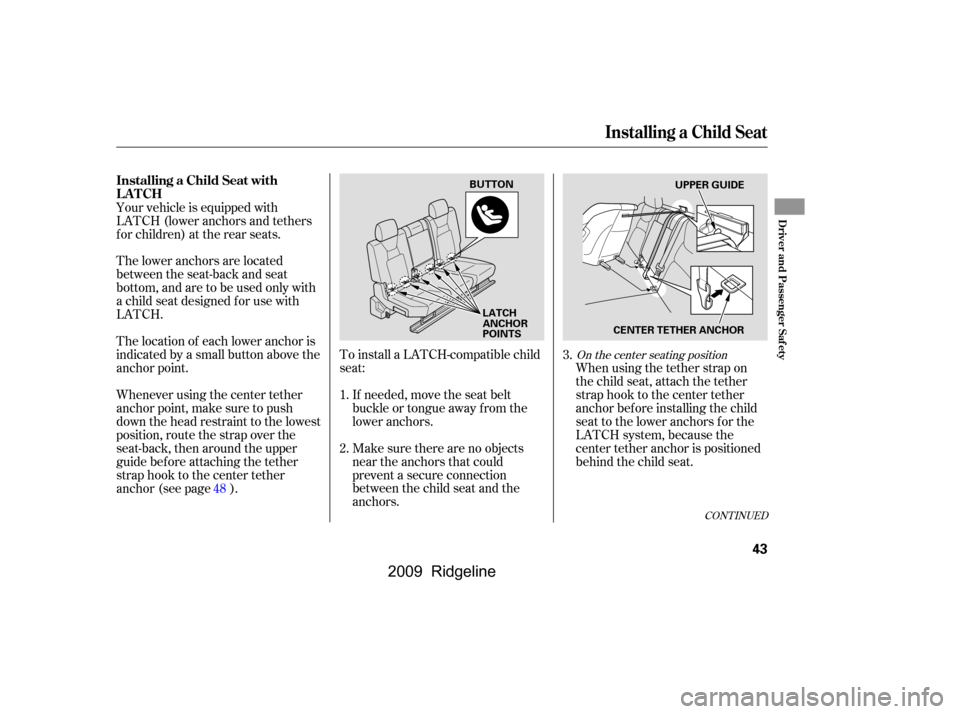
To install a LATCH-compatible child
seat:Make sure there are no objects
near the anchors that could
prevent a secure connection
between the child seat and the
anchors. When using the tether strap on
the child seat, attach the tether
strap hook to the center tether
anchor bef ore installing the child
seat to the lower anchors f or the
LATCH system, because the
center tether anchor is positioned
behind the child seat.
If needed, move the seat belt
buckle or tongue away f rom the
lower anchors.
Your vehicle is equipped with
LATCH (lower anchors and tethers
f or children) at the rear seats.
The lower anchors are located
between the seat-back and seat
bottom, and are to be used only with
a child seat designed f or use with
LATCH.
The location of each lower anchor is
indicated by a small button above the
anchor point.
Whenever using the center tether
anchor point, make sure to push
down the head restraint to the lowest
position, route the strap over the
seat-back, then around the upper
guide bef ore attaching the tether
strap hook to the center tether
anchor (see page ).
1.
2.3.
48
CONT INUED
On the center seating position
Installing a Child Seat
Installing a Child Seat with
LATCH
Driver and Passenger Saf ety
43
BUTTON UPPERGUIDE
CENTER TETHER ANCHOR
LATCH
ANCHOR
POINTS
�\f���—�\f���—�\f���y�
�������������y���
�(���������\f�y�\f�\f�����y
2009 Ridgeline
Page 49 of 427
Lif t the head restraint (see page), then route the tether strap
over the seat-back and through
the head restraint legs.
Lift the cover, then route the
tether strap around the upper
guide. Route the tether strap
downward properly, making sure
the strap is not twisted, then
attach the strap hook to the tether
anchor on the outside of the seat
bottom (see page ). Push and pull the child seat
f orward and f rom side-to-side to
verify that it is secure. Tighten the strap according to the
seat maker’s instructions.
6.
7.
8.
48
123
On the outer seating position
Installing a Child Seat
Driver and Passenger Saf ety
45
UPPER
GUIDE
Outer Position UPPER
GUIDE
Center Position TETHER ANCHOR
TETHER ANCHOR
�����—�����—�����y�
�������������y���
�(�����������y���������y
2009 Ridgeline
Page 50 of 427
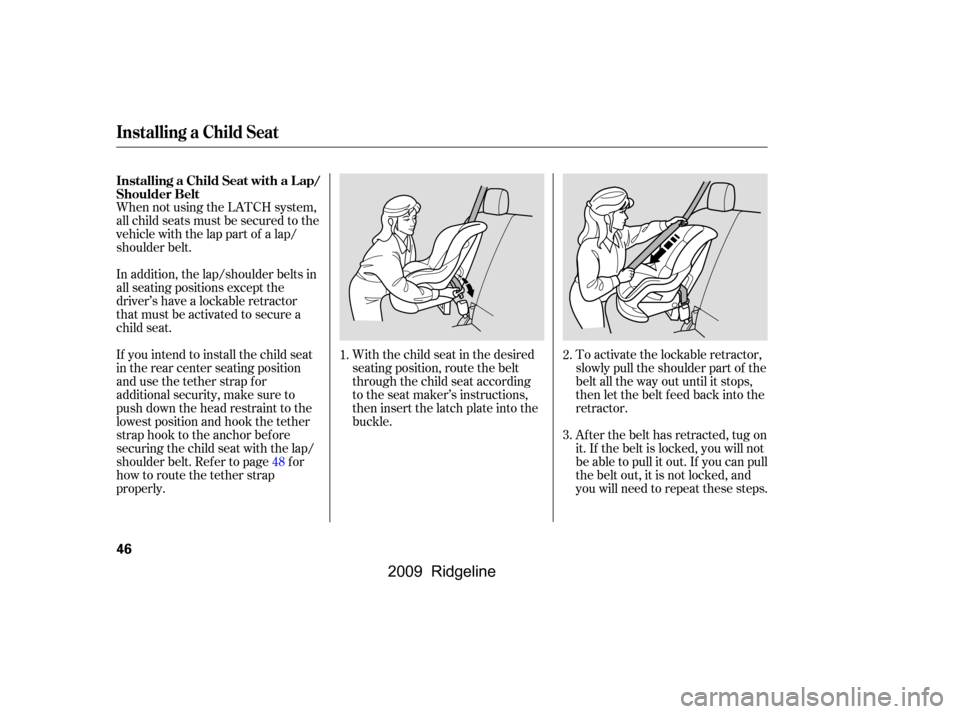
When not using the LATCH system,
all child seats must be secured to the
vehicle with the lap part of a lap/
shoulder belt.With the child seat in the desired
seating position, route the belt
through the child seat according
to the seat maker’s instructions,
then insert the latch plate into the
buckle.To activate the lockable retractor,
slowly pull the shoulder part of the
belt all the way out until it stops,
then let the belt f eed back into the
retractor.
Af ter the belt has retracted, tug on
it. If the belt is locked, you will not
be able to pull it out. If you can pull
thebeltout,itisnotlocked,and
you will need to repeat these steps.
In addition, the lap/shoulder belts in
all seating positions except the
driver’s have a lockable retractor
that must be activated to secure a
child seat.
If you intend to install the child seat
in the rear center seating position
and use the tether strap for
additional security, make sure to
push down the head restraint to the
lowest position and hook the tether
strap hook to the anchor bef ore
securing the child seat with the lap/
shoulder belt. Ref er to page f or
how to route the tether strap
properly.
1.
2.
3.
48
Installing a Child Seat with a L ap/
Shoulder Belt
Installing a Child Seat
46
�\f���—�\f���—�\f���y�
�������������y���
�(���������\f�y�\f�\f���
�y
2009 Ridgeline
Page 51 of 427
Af ter conf irming that the belt is
locked, grab the shoulder part of
the belt near the buckle, and pull
up to remove any slack from the
lap part of the belt. Remember, if
the lap part of the belt is not tight,
the child seat will not be secure.Push and pull the child seat
f orward and f rom side-to-side to
verify that it is secure enough to
stay upright during normal driving
maneuvers. If the child seat is not
secure, unlatch the belt, allow it to
retract f ully, then repeat these
steps.
To remove slack, it may help to
putweightonthechildseat,or
push on the back of the seat while
pulling up on the belt. To deactivate the lockable retractor
and remove a child seat, unlatch the
buckle, unroute the seat belt, and let
the belt fully retract.
4. 5.
Installing a Child Seat
Driver and Passenger Saf ety
47
�\f���—�\f���—�\f���y�
�����������\f�y���
�(���������\f�y�\f�\f�����y
2009 Ridgeline
Page 52 of 427
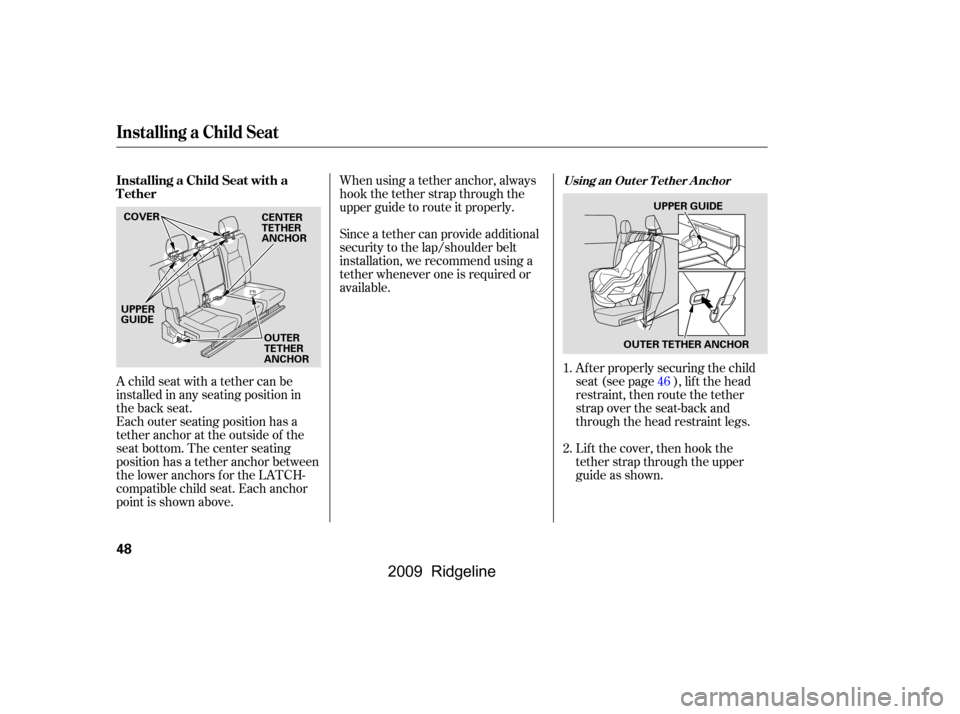
When using a tether anchor, always
hook the tether strap through the
upper guide to route it properly.
Since a tether can provide additional
security to the lap/shoulder belt
installation, we recommend using a
tether whenever one is required or
available.
Each outer seating position has a
tether anchor at the outside of the
seat bottom. The center seating
position has a tether anchor between
the lower anchors f or the LATCH-
compatible child seat. Each anchor
point is shown above. Lif t the cover, then hook the
tether strap through the upper
guide as shown.
Af ter properly securing the child
seat (see page ), lif t the head
restraint, then route the tether
strap over the seat-back and
through the head restraint legs.
A child seat with a tether can be
installed in any seating position in
the back seat. 1.
2.46
Installing a Child Seat
Installing a Child Seat with a
TetherUsing an Out er T et her A nchor
48
COVER
UPPER
GUIDE UPPER
GUIDE
CENTER
TETHER
ANCHOR
OUTER
TETHER
ANCHOR OUTER TETHER ANCHOR
�\f���—�\f���—�\f���y�
�������������y���
�(���������\f�y�\f�\f�����y
2009 Ridgeline
Page 54 of 427
Attach the tether strap hook to the
center tether anchor between the
loweranchorsfortheLATCH-
compatible child seat.Properlysecurethechildseat(see
page ), then tighten the tether
strap according to the seat maker’s
instructions.
Whenever using the tether strap,
make sure to route the strap through
the upper guide bef ore attaching the
tether strap hook to the tether
anchor. If the tether strap is not
routed properly and secured, the
child seat may not be secured. This
could lead to serious injury or death.
5. 6.
46
Installing a Child Seat
50
UPPER GUIDE
CENTER TETHER ANCHOR
�\f���—�\f���—�\f���y�
������\f��
���y���
�(���������\f�y�\f�\f�����y
2009 Ridgeline
Page 57 of 427
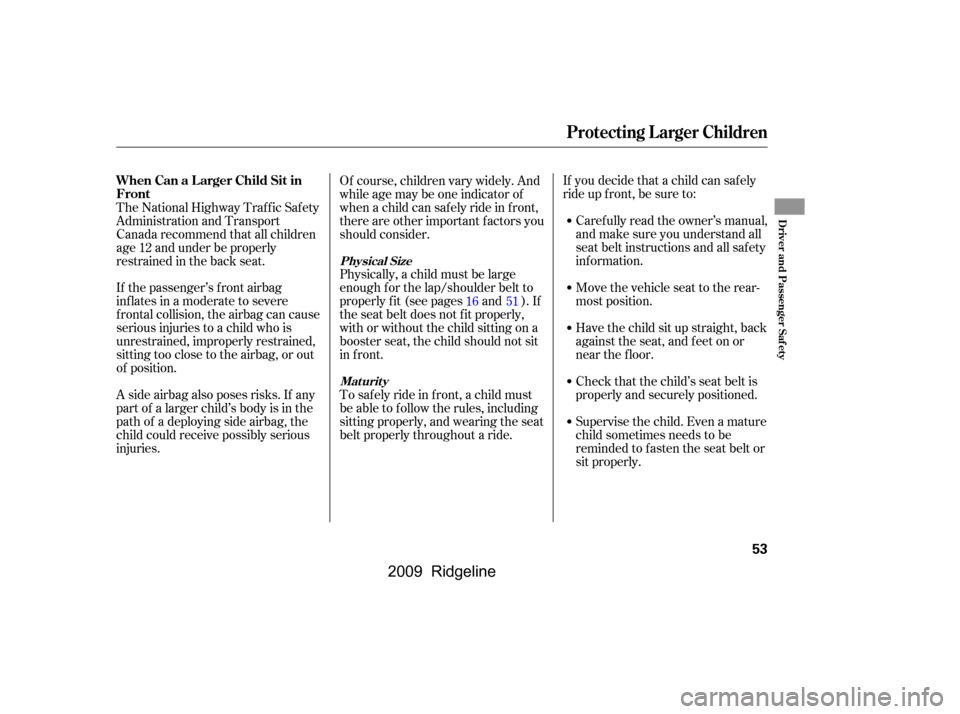
If you decide that a child can saf ely
ride up f ront, be sure to:Caref ully read the owner’s manual,
and make sure you understand all
seat belt instructions and all saf ety
inf ormation.
Move the vehicle seat to the rear-
most position.
Have the child sit up straight, back
against the seat, and feet on or
near the f loor.
Check that the child’s seat belt is
properly and securely positioned.
Physically, a child must be large
enough f or the lap/shoulder belt to
properly f it (see pages and ). If
the seat belt does not f it properly,
with or without the child sitting on a
booster seat, the child should not sit
in f ront.
To saf ely ride in f ront, a child must
be able to f ollow the rules, including
sitting properly, and wearing the seat
belt properly throughout a ride.
A side airbag also poses risks. If any
part of a larger child’s body is in the
path of a deploying side airbag, the
child could receive possibly serious
injuries.
If the passenger’s front airbag
inf lates in a moderate to severe
f rontal collision, the airbag can cause
serious injuries to a child who is
unrestrained, improperly restrained,
sitting too close to the airbag, or out
of position.
The National Highway Traffic Safety
Administration and Transport
Canada recommend that all children
age 12 and under be properly
restrained in the back seat. Of course, children vary widely. And
while age may be one indicator of
when a child can saf ely ride in f ront,
there are other important f actors you
should consider.
Supervise the child. Even a mature
child sometimes needs to be
reminded to f asten the seat belt or
sit properly.
1651
Physical Size
Maturity
When Can a L arger Child Sit in
Front
Protecting L arger Children
Driver and Passenger Saf ety
53
�\f���—�\f���—�\f���y�
������\f����\f�y���
�(���������\f�y�\f�\f�����y
2009 Ridgeline
Page 65 of 427
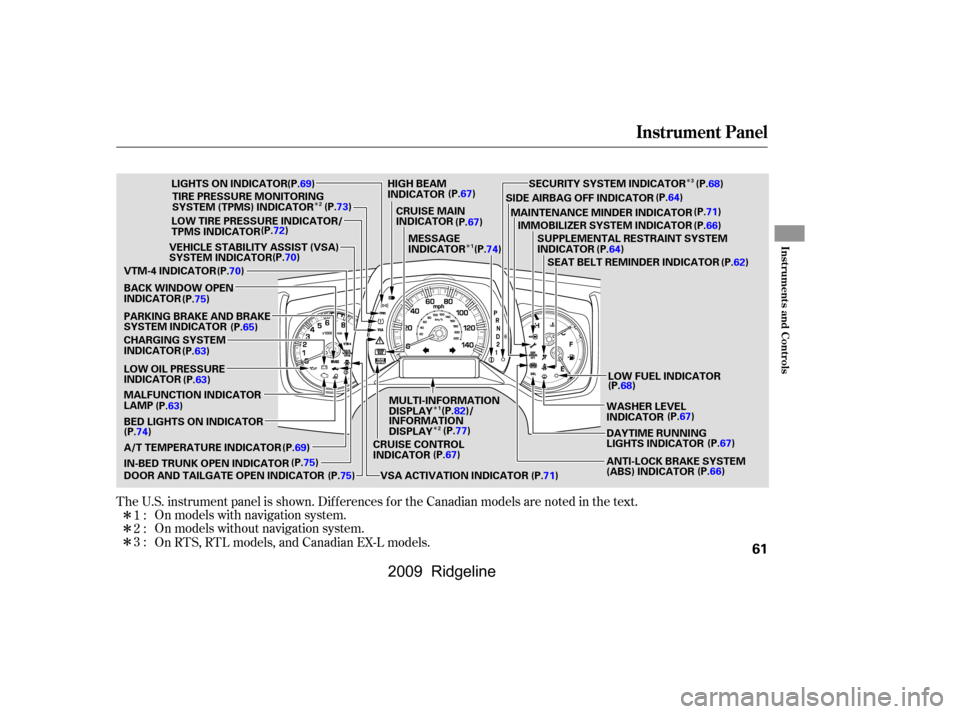
�Î
�Î
�Î
�Î �Î�Î
�Î
�Î
On models without navigation system. On models with navigation system.
The U.S. instrument panel is shown. Dif f erences f or the Canadian models are noted in the text.
1:
2:
3: On RTS, RTL models, and Canadian EX-L models.
Instrument Panel
Inst rument s and Cont rols
61
LOW FUEL INDICATOR
MAINTENANCE MINDER INDICATOR
IMMOBILIZER SYSTEM INDICATOR
SEAT BELT REMINDER INDICATOR
SUPPLEMENTAL RESTRAINT SYSTEM
INDICATOR
CRUISE MAIN
INDICATOR
CRUISE CONTROL
INDICATOR
VEHICLE STABILITY ASSIST (VSA)
SYSTEM INDICATOR
VTM-4 INDICATOR
BACK WINDOW OPEN
INDICATOR
PARKING BRAKE AND BRAKE
SYSTEM INDICATOR
CHARGING SYSTEM
INDICATOR
LOW OIL PRESSURE
INDICATOR
BED LIGHTS ON INDICATOR
A/T TEMPERATURE INDICATOR
IN-BED TRUNK OPEN INDICATOR (P.72)
(P.70)
(P.70)
(P.75) (P.65)
(P.63)
(P.63)
MALFUNCTION INDICATOR
LAMP (P.63)
(P.74) (P.69)(P.75) (P.82)/
INFORMATION
DISPLAY MULTI-INFORMATION
DISPLAY
(P.77)
(P.67) (P.71)(P.68) (P.62)
(P.64) (P.66) (P.71)
SIDE AIRBAG OFF INDICATOR
(P.64)
(P.67)
MESSAGE
INDICATOR (P.74)
DOOR AND TAILGATE OPEN INDICATOR (P.75) WASHER LEVEL
INDICATOR
DAYTIME RUNNING
LIGHTS INDICATOR
(P.67)
(P.67)
ANTI-LOCK BRAKE SYSTEM
(ABS) INDICATOR (P.66)
VSA ACTIVATION INDICATOR (P.67)
SECURITY SYSTEM INDICATOR (P.68)
HIGH BEAM
INDICATOR
LIGHTS ON INDICATOR
LOW TIRE PRESSURE INDICATOR/
TPMS INDICATOR TIRE PRESSURE MONITORING
SYSTEM (TPMS) INDICATOR
(P.69)
(P.73)
2 1 1
3
2
�����—�����—�����y�
������
������y���
�(�����������y���������y
2009 Ridgeline